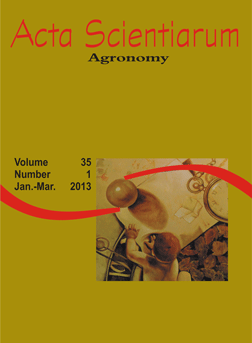<b>Association between glucosinolate concentration and injuries caused by cabbage stink bugs <i>Eurydema</i> spp. (Heteroptera: Pentatomidae) on different Brassicas</b> - doi: 10.4025/actasciagron.v35i1.15622
Abstract
In 2010, we were determining the contents of glucosinolates in different Brassicas in order to study their influence on feeding of cabbage stink bugs (Eurydema spp.) and the consequent extent of damage. We confirmed that glucosinolates content depends on plant species, plant organs and the time of sampling. In the samples aliphatic glucosinolates (glucoiberin, progoitrin, epiprogoitrin, epiprogoitrin, sinigrin, gluconapin, glucoraphenin, sinalbin) prevailed. Glucobrassicin, an important indolic glucosinolate compound, was detected in all tested Brassicas. Its concentration in the oil radish samples was highest during the first assessment (30 DAS), 8.84 ± 0.65 µmol g-1 ds, while the oilseed rape samples displayed lowest concentration during the last assessment (134 DAS), 4.30 ± 0.80 µmol g-1 ds. The stimulative activity of individual glucosinolates or their negative influence on feeding of cabbage stink bugs in the Brassicas used in our experiment was not uniformly manifested. Based on a two-year field experiment we concluded that oil rape was the most adequate trap crop used to allure cabbage stink bugs. In future, glucosinolates should be employed to a greater extent in environmentally acceptable ways of food production, one of which is also the use of trap crops in order to reduce harmful effects of cabbage stink bugs.
Downloads
DECLARATION OF ORIGINALITY AND COPYRIGHTS
I Declare that current article is original and has not been submitted for publication, in part or in whole, to any other national or international journal.
The copyrights belong exclusively to the authors. Published content is licensed under Creative Commons Attribution 4.0 (CC BY 4.0) guidelines, which allows sharing (copy and distribution of the material in any medium or format) and adaptation (remix, transform, and build upon the material) for any purpose, even commercially, under the terms of attribution.




















































